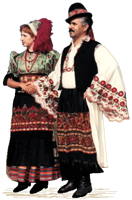
|
The Society of Folk Dance Historians (SFDH)
Csárdás
[
Home |
About |
Encyclopedia | CLICK AN IMAGE TO ENLARGE |

|
BACKGROUND
 Information: I first encountered the Csárdás around 1962 with Andor Czompo and it continues to be my favorite dance. My only sorrow is that the dance never got into the American social dance repertoire.
Information: I first encountered the Csárdás around 1962 with Andor Czompo and it continues to be my favorite dance. My only sorrow is that the dance never got into the American social dance repertoire.
Just to review a bit of the Csárdás' history, it is said that it was the height of fashion 200 years ago. That's a bit optimistic by my sources. The dance began in the village pub, called to this day, "csárdá." This was an all-male environment and women frequenting the place were considered to be rather "loose" by standards of the day. Thus, the dance was considered to be immoral and improper for women who did not frequent the csárdá, not unlike the tango which was the preferred dance of the Buenos Aires underworld.
The spelling Czardas is an older spelling, long ago evolved into the current Csárdás (The Slovak spelling is Čardáš and the Yugoslavian spelling is Čardaš.)
Though the dance has definite local variations throughout the Hungarian-speaking world, it has some characteristics in general. They usually start slowly (to allow the men to recover from the men's dance which just preceded it) and increases tempo in stages to a rapid and energetic ending.
The older forms of the dance tend to remain in place, while the newer forms (dating from the mid-19th Century) allow considerable movement across the floor. Whether space limitations or availability is the cause is a matter of conjecture. Interestingly, boot stamps are a common motif when danced on a wood floor, but they disappear when the dance occurs outdoors.
The most common dance position is what Andor calls a "shoulder-shoulder blade" position with partners facing each other squarely, the man's hands high on the woman's back. It's very possible to perform the dance symmetrically, with figures danced in either direction, however, most men tend to favor one side or another when leading – the dance is, by the way, led and improvised by the man, who controls every step his partner dances unless he releases her.
The dance is founded on two dance steps: the "csárdás" step and the "rida," the former a "step-close-step-touch" figure which can rotate slightly, stay in place, or travel across the floor; the "rida" is a "side-cross" or "cross-side" step with which the couple spins together or individually.
Being basically a horse culture, men wear riding boots and dance with all the accompanying heel-clicks, stamps, and boot slaps that boot-wearers usually incorporate into their dance. All manner of syncopated stamps and slapping figures, often performed while spinning the woman, are found throughout Hungary and Transylvania. Frequently, the partners separate and interpret the dance in their own favorite motifs before rejoining in the dance. Again, many of the motifs are very localized and clearly identify the area of the dance's origin.
Zoltá Zsuráfszki appropriately calls it the "Tango of the East" and the dance is indeed that. Though it lacks the smoldering intensity of the Latinized tango, the Csárdás expresses a freedom and exuberance totally lacking in the tango, indicative of the wide open spaces of Hungary.
Though the Csárdás offers great opportunity for the couple dancer to develop remarkable dance skills, it is perhaps best danced with no more than four to six figures with which the man may construct a dance which will charm and delight his partner. It develops a teamwork between man and woman which is always a special relationship. The man does not dominate his partner, he leads and supports her as an equal partner in the dance.
The Csárdás is probably the southernmost extent of the couple dance in Europe, influenced by the dance practices of the Renaissance which ended at the border with the Ottoman Empire. At that point, the Csárdás disappears in the dances which reflect the Muslim values implanted in the Balkans by the Turks.
DOCUMENTS
- Andor Czompo, an article.
- Csárdás and Verbunk, dances.
- Hungarian Dance Names, an article.
- Hungarian Dances, an article.
- Hungarian Folk Dance Types and Dialects, an article.
- Hungary, a country.
- Richard Duree, an article.
This page © 2018 by Ron Houston.
Please do not copy any part of this page without including this copyright notice.
Please do not copy small portions out of context.
Please do not copy large portions without permission from Ron Houston.